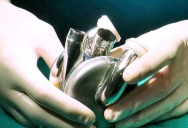The First Titanium Artificial Heart Was Successfully Implanted Into Human Patient During Clinical Trial

Heart disease is one of the leading causes of death around the world.
For many people living with a bad heart, getting on the waiting list for a transplant can seem daunting, much less actually living long enough to make it to the top of the list.
Sadly, there are millions of people waiting for heart transplants, but fewer than 4000 in the United States get one each year.
BiVACOR is a company that is looking to solve that problem.
They have developed a titanium artificial heart that has been approved for trials, and was actually implanted into a patient in July of 2024.
The patient lived with this artificial heart for eight days until he qualified for a human heart transplant.
The clinical trials have been approved for up to five human patients at this time, so it is likely that there will be four more patients receiving this opportunity in the near future.

Dr. Alexis Shafii is the Surgical Director of Heart Transplantation at Baylor St. Luke’s Medical Center and has issued a statement about this exciting new type of artificial heart.
“This is an amazing advancement as the BiVACOR TAH may offer hope for countless patients who suffer from end-stage heart failure. This device may serve as a life-saving bridge to a heart transplant; future studies may prove its potential as a long-term pump that can effectively serve as a total replacement for a patient’s heart.”
This new design is about the same size as a normal human heart, which gives it advantages over previous artificial hearts that were significantly larger.
It is made up of two ventricles, just like a natural heart, with one of them sending blood to the lungs and the other circulating the blood throughout the rest of the body.
Unlike a natural heart that pumps blood using contracting muscles, however, this artificial heart uses a rotating impeller to move the blood around.
One of the key advancements with this heart is that it uses MAGLEV technology, which stands for magnetic levitation.
If you have heard of it before, it is likely because it is the same technology used in high-speed trains in Japan and other countries.
This impeller technology allows the blood to circulate more easily with minimal trauma to the blood itself.

In addition, it dramatically cuts down on the mechanical wear to the artificial heart itself, which was a significant problem with other designs.
This artificial heart comes with an external battery and a controller. With the controller, the patient and their doctor can increase or decrease the flow of blood to allow the patient to engage in normal activities, including moderate exercise, without a problem.
While the first trial was only for eight days, and the current approved use for this heart is for shorter term use while waiting for a heart transplant, many are hopeful that it will also be able to serve as a long term solution to many who would otherwise be unable to get a transplant at all.
Prior to the human trials, the heart was implanted into calves, where it was used for a month to prove its lasting ability. One of the devices has also been operating for over four years in the medical lab where it was first created.
This is very promising news for anyone living with heart disease.
If you found that story interesting, learn more about why people often wake up around 3 AM and keep doing it for life.

Sign up to get our BEST stories of the week straight to your inbox.




